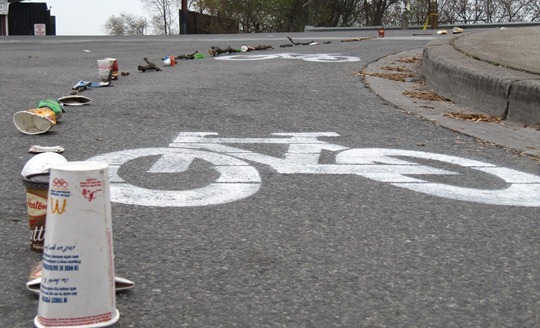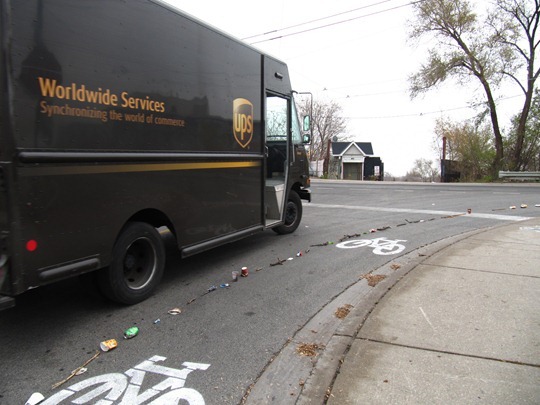As many of you already know, construction on the Kinzie Street cycle track is set to begin tomorrow. When I first heard the news, I was excited, but also a bit confused. While it certainly sounded like a good thing, I wasn't quite sure what a cycle track was. Not to mention, how it might differ from a bike lane or a bike boulevard.
I asked a friend of mine who works in city planning for some clarification, and she was good enough to compile the definitions you see below (and also on my blog at www.iblockthebikelane.com). Perhaps you'll find them helpful, too!
Marked Shared Lane – A marked shared lane is a vehicular travel lane that has been marked with a shared lane marking, or colloquially, sharrow. It is often a little wider than a normal travel lane, but probably not wide enough for a bike lane. The shared lane marking is comprised of a bicycle below two chevrons placed towards the middle- right side of the lane to indicate that the lane is intended to be shared by bicycles and vehicles.
Bike Lane – A bike lane is probably self-explanatory by now. It’s an on-street lane designated for bikes with a stripe separating it from vehicular traffic on one side and from parked cars on the other, if parking is allowed. Inside the lane, a pavement marking of a bike with a single arrow is typically used. Bike lanes may also be next to a curb. Typically, bike lanes are found to the right of moving traffic, but may also be found on the left on one-way streets or to allow reverse direction bicycle traffic.
Buffered Bike Lane – A buffered bike lane is a regular bike lane on steroids. It has a buffer between the bike lane and vehicular lane or between the bike lane and parking, or both, using only pavement markings on the surface of the road to create the buffer. Like the bike lane it builds on, it is typically located between the moving traffic lanes and parking.
Cycle Track/Protected Bike Lane/Separated Bike Lane – Cycle tracks, also referred to as protected bike lanes, separated bike lanes, or as in New York City, on-street bike paths, are essentially more intensive buffered bike lanes but with a twist. They are on-street bike lanes that are separated from vehicular traffic by a physical barrier usually by flipping the location of the bikes and parked cars so the parking becomes a barrier from moving traffic. A variety of other barriers can be used – flexible delineator posts, bollards, planters, a curb, or a number of other items. The cycle track could also be grade separated – raised a few higher than the rest of the road – to ward off motorists. This last variety has also been called a raised bike lane.
Bicycle Boulevard – A bicycle boulevard is quite different from the rest of the above facilities. Up to now, we’ve discussed variations on bike lanes that would be found on streets with moderate to heavy vehicle traffic. Bicycle boulevards transform local or low-volume streets into comfortable and convenient thoroughfares for bicyclists. A street designated as a bicycle boulevard has priority over other local streets because the cross-streets have stop signs while the bicycle boulevard has the right of way. Meanwhile, vehicular traffic is limited to only local traffic. Intermittently along the boulevard, barriers and diverters prevent vehicles from traveling through, but they incorporate cut-throughs for the bicyclists to continue.



